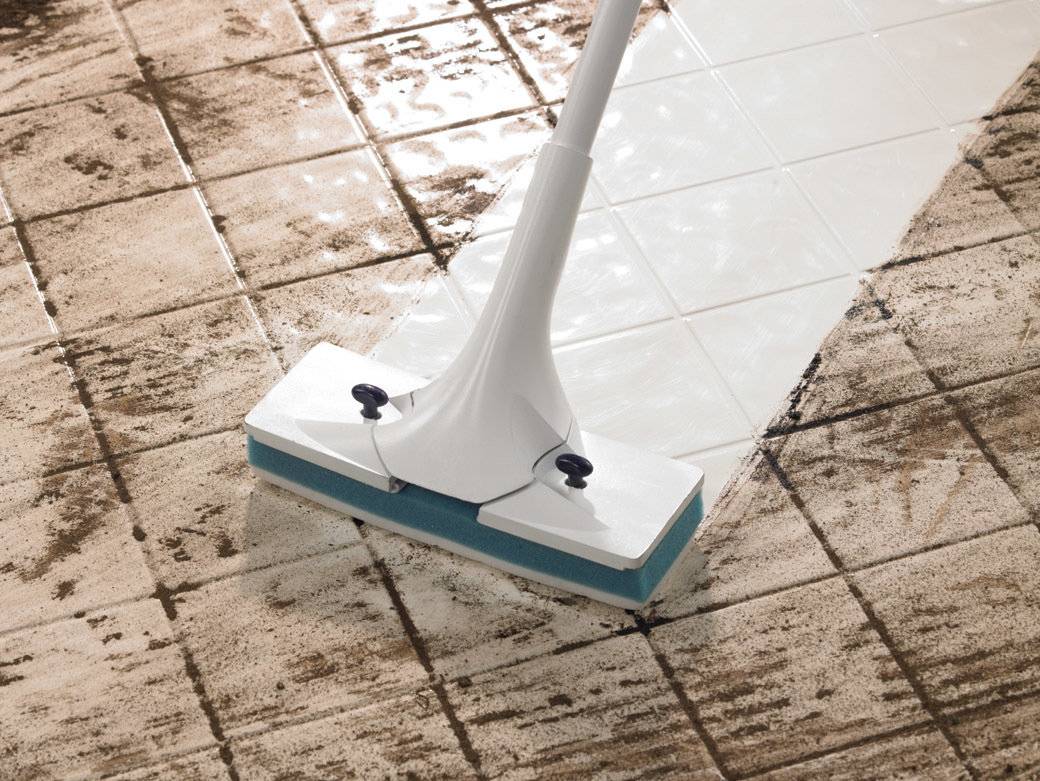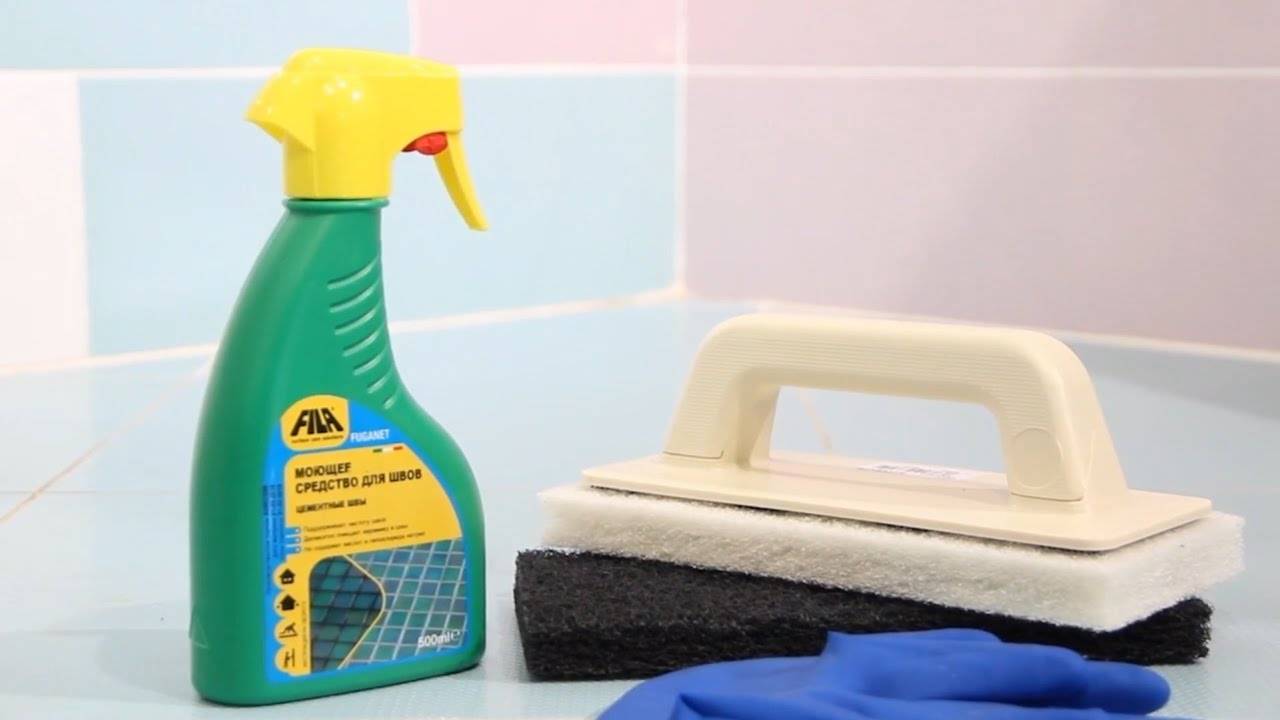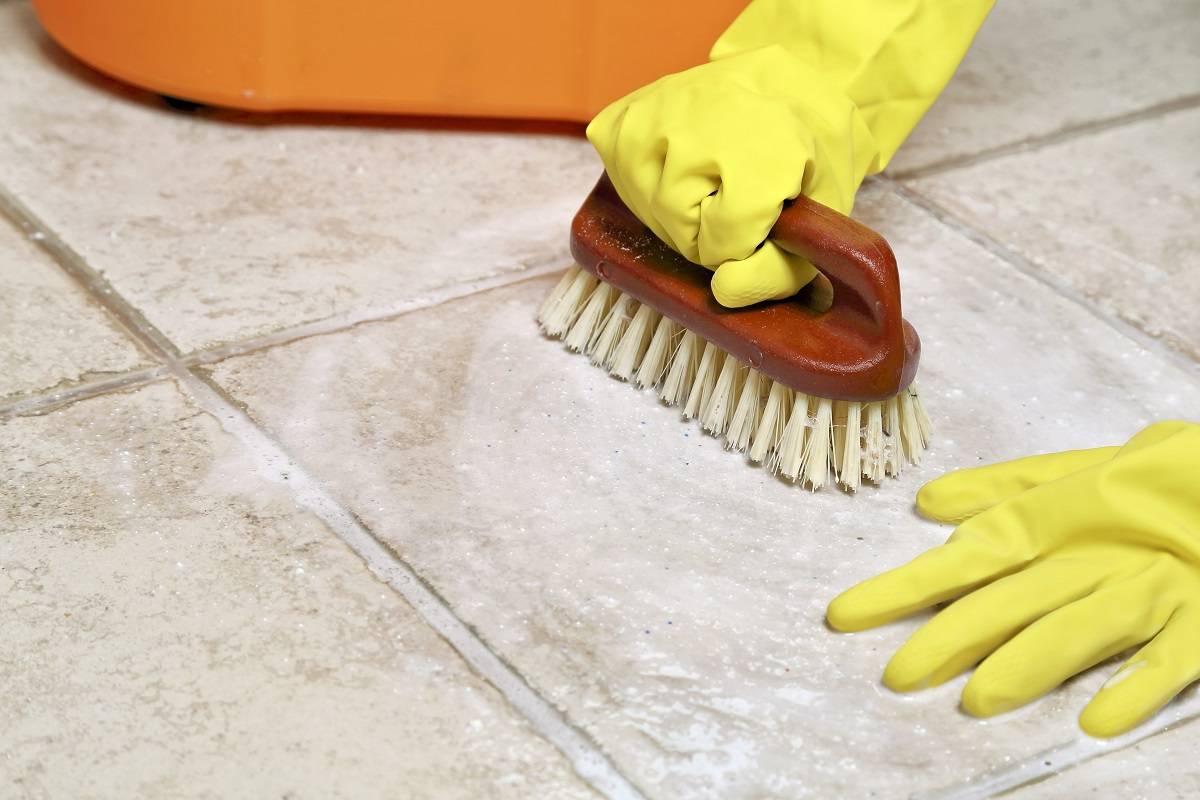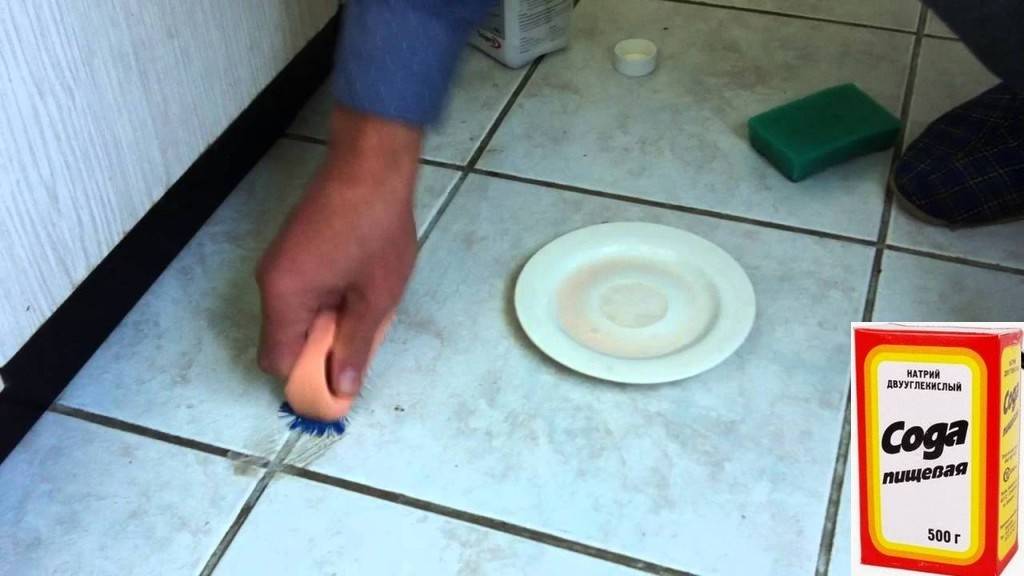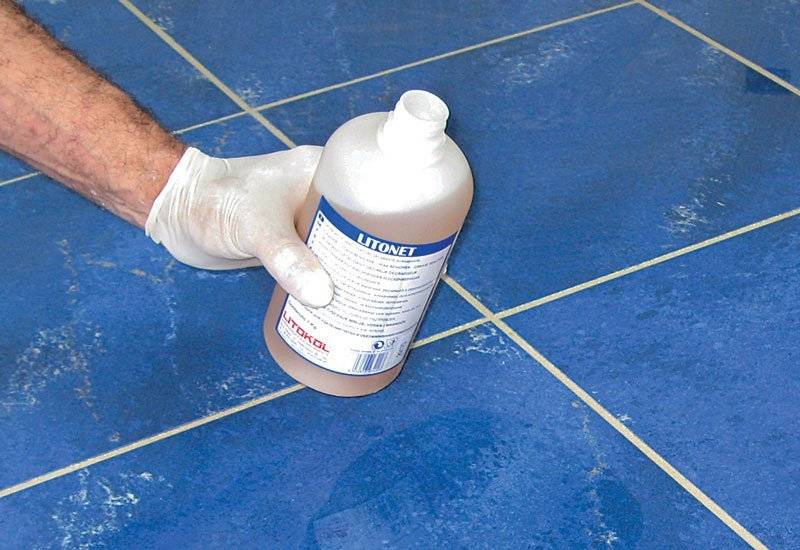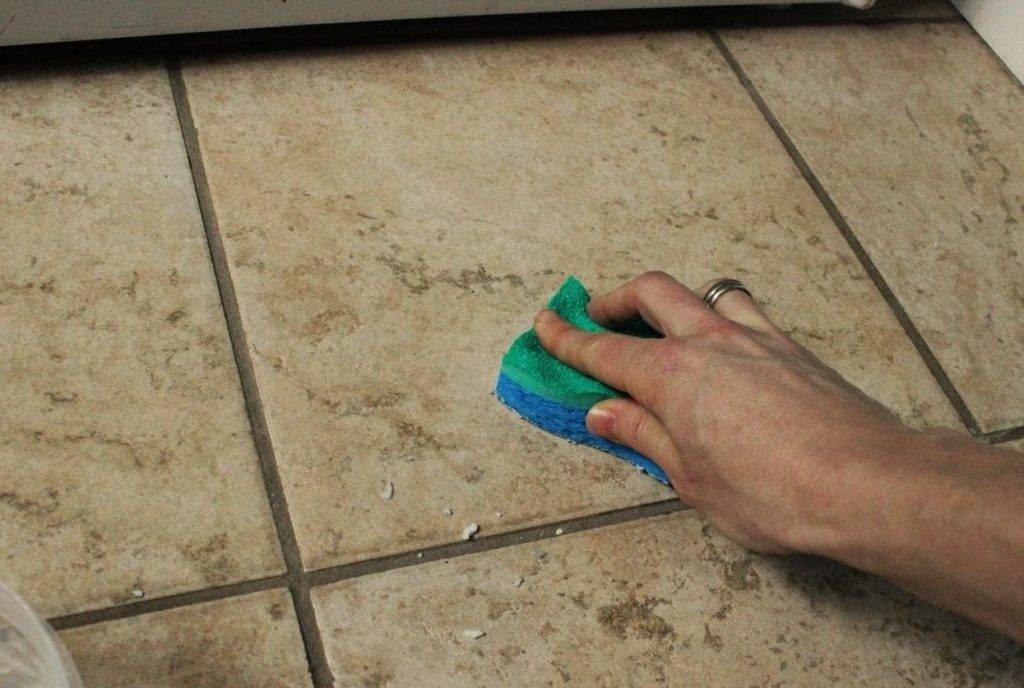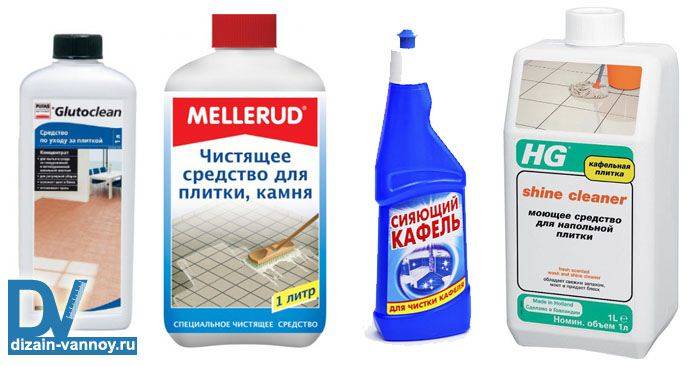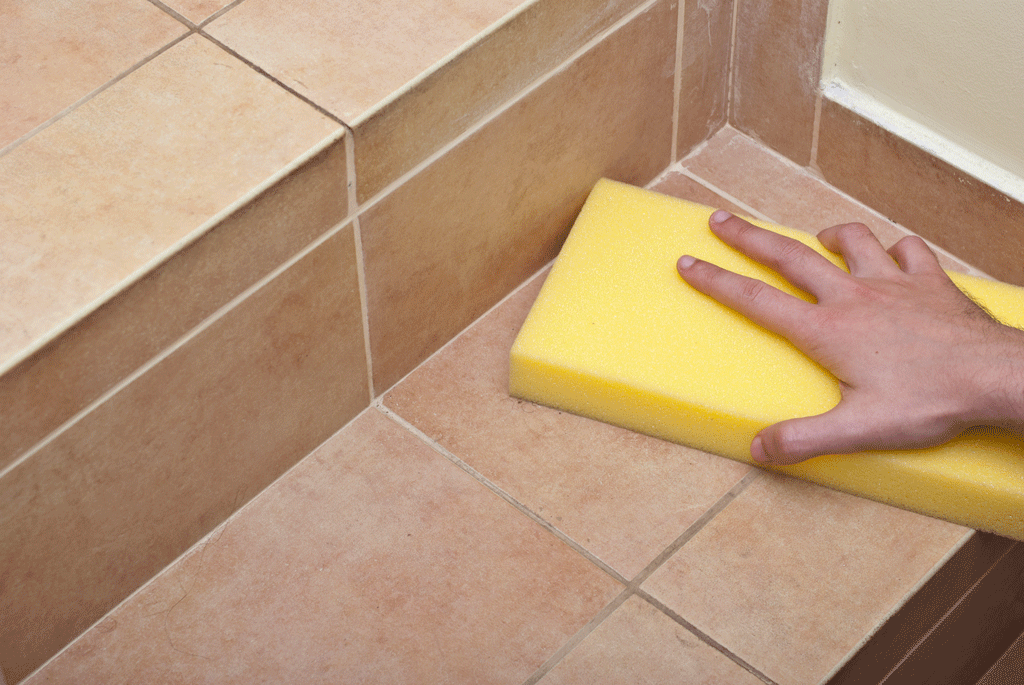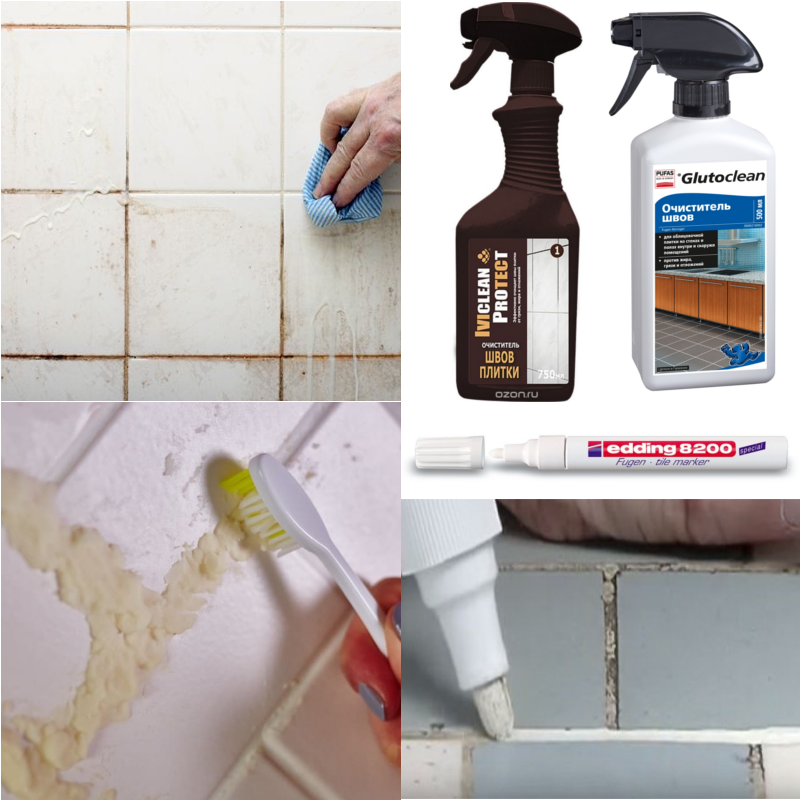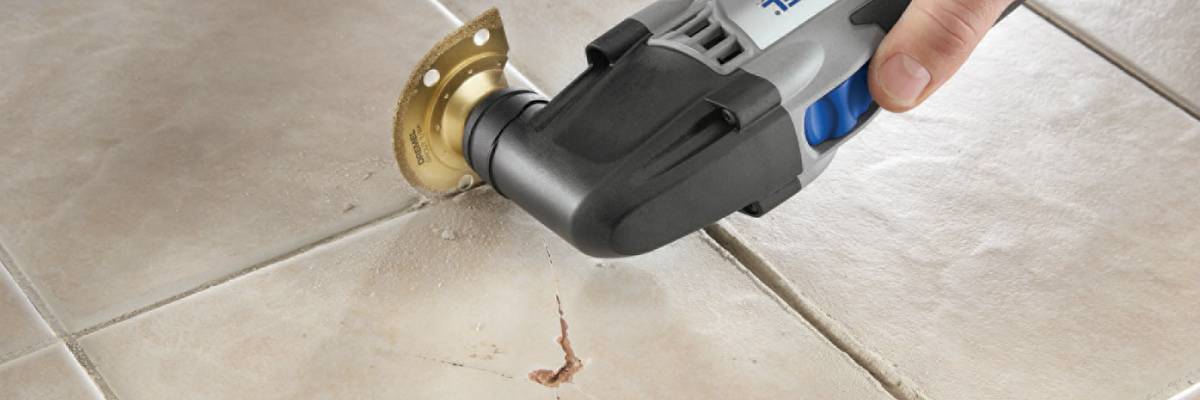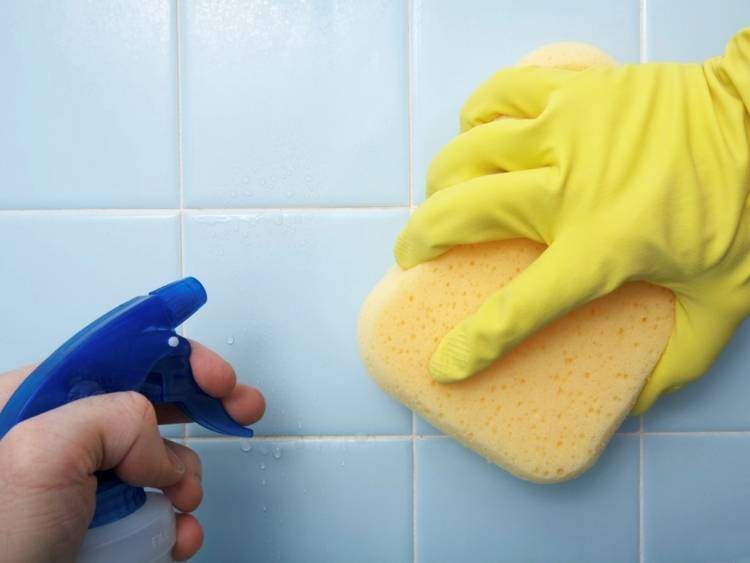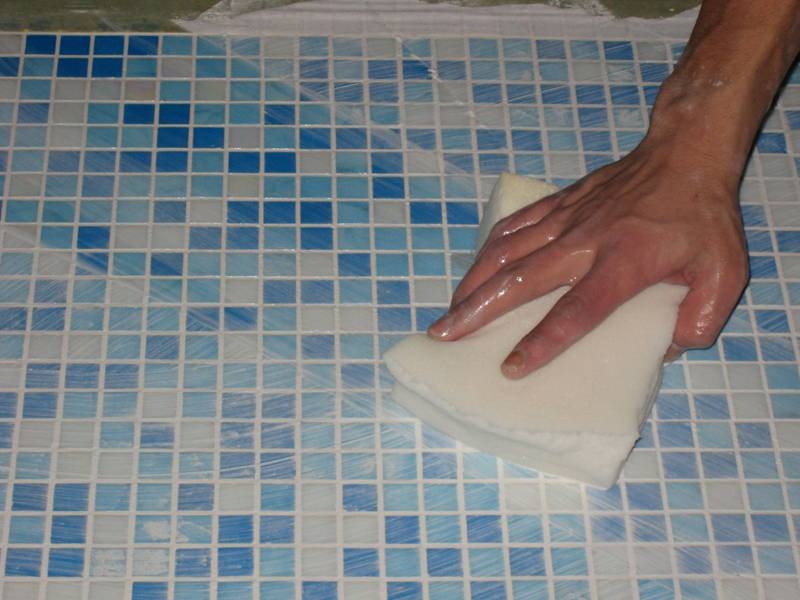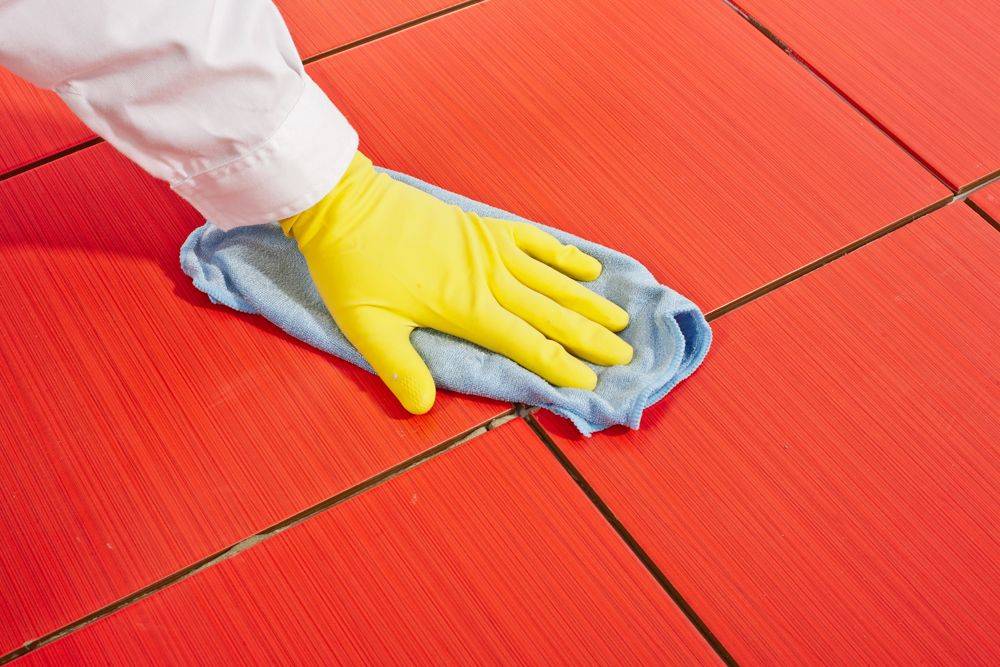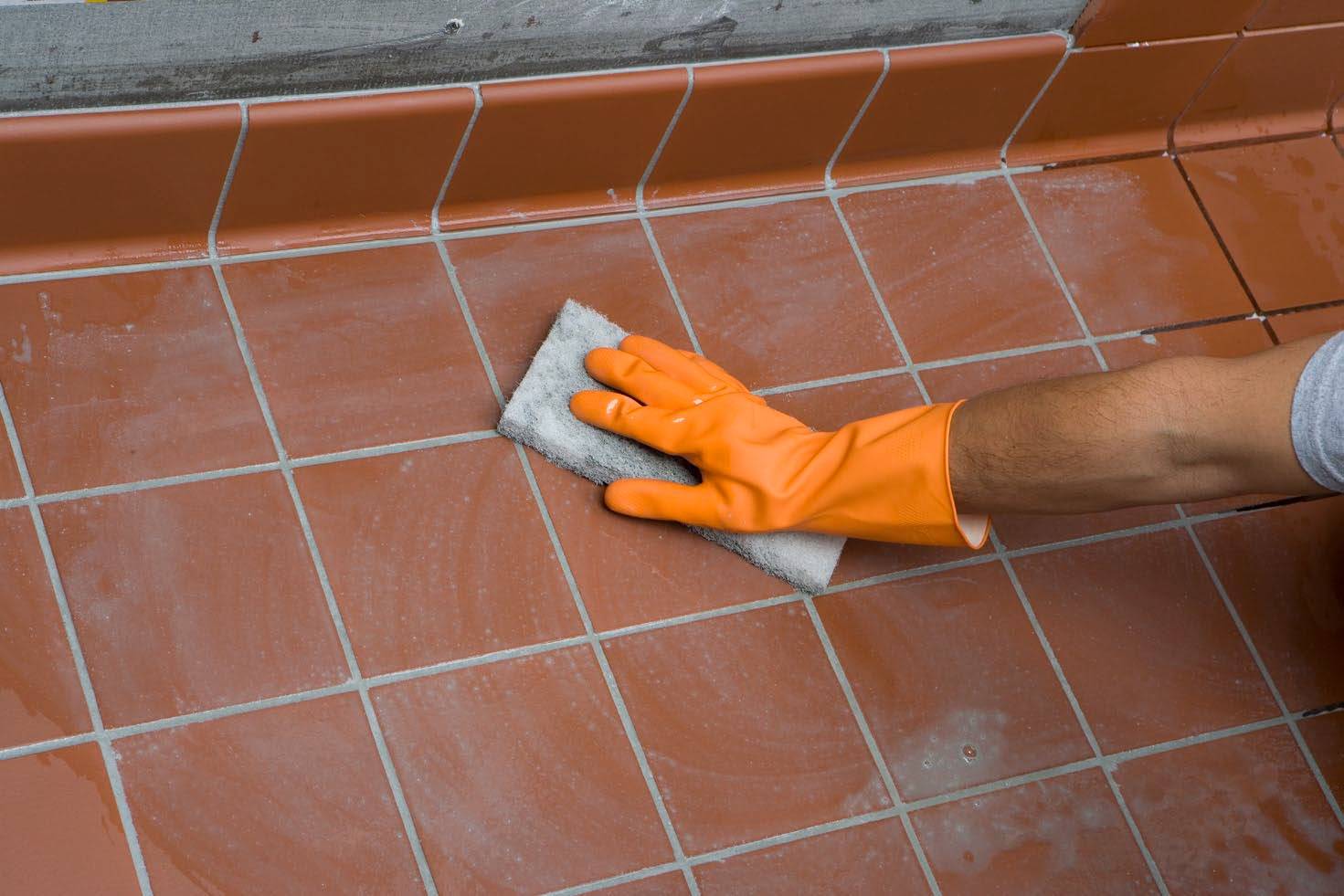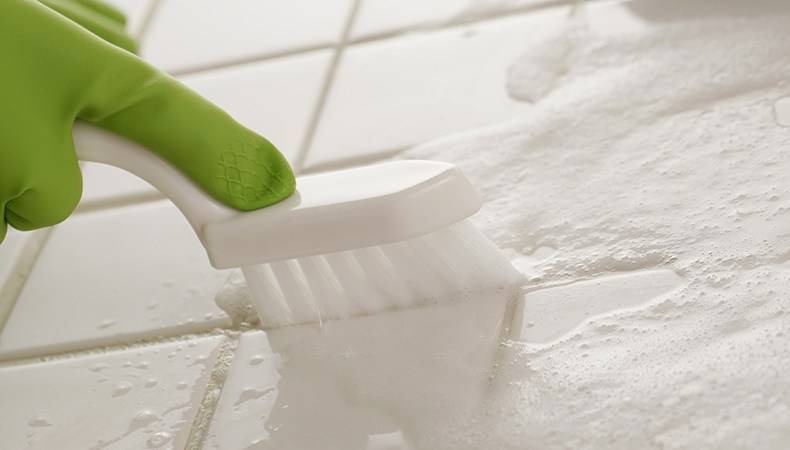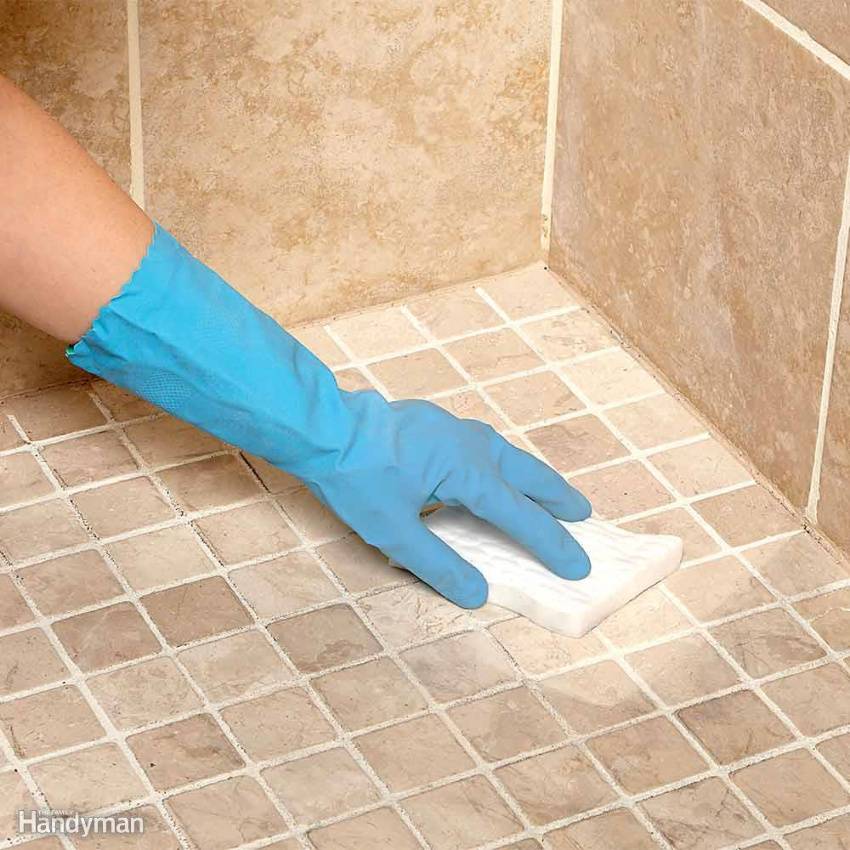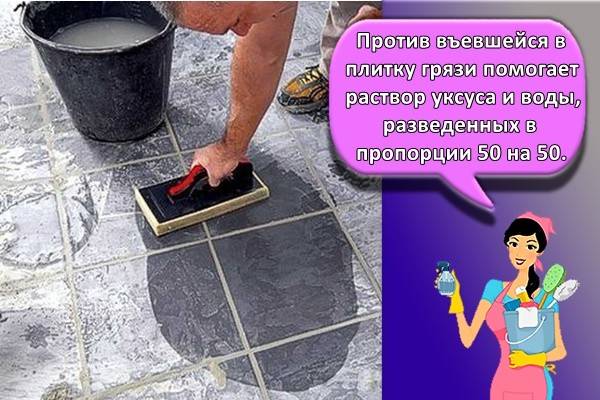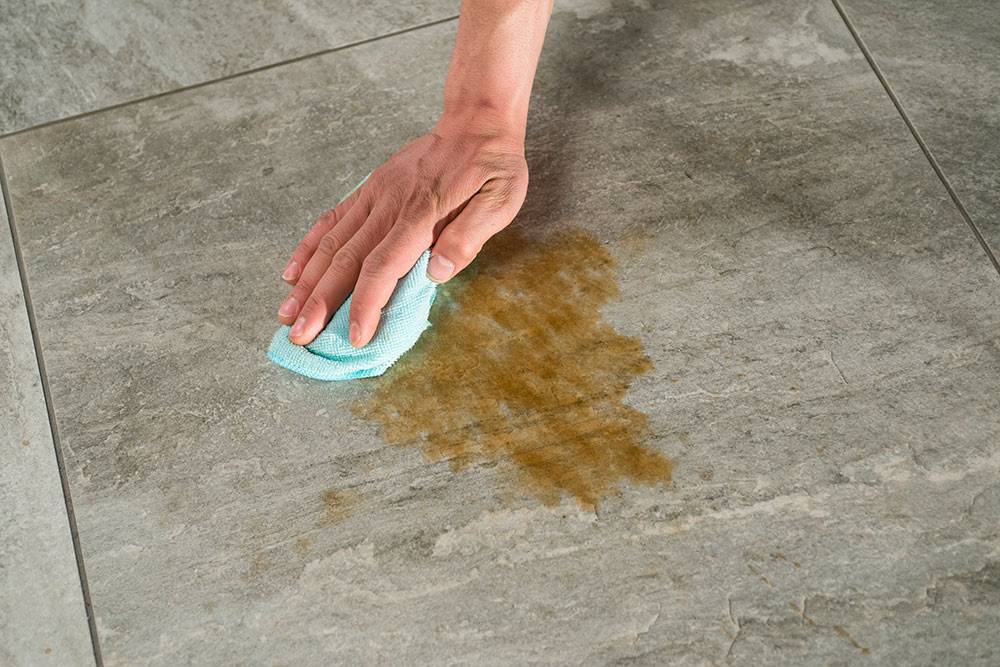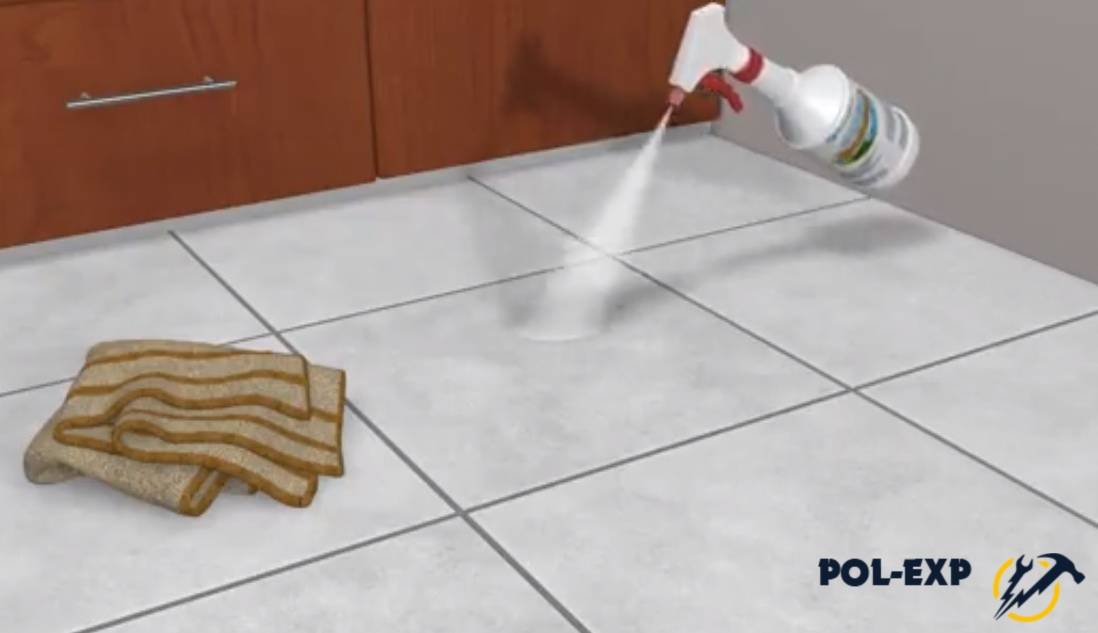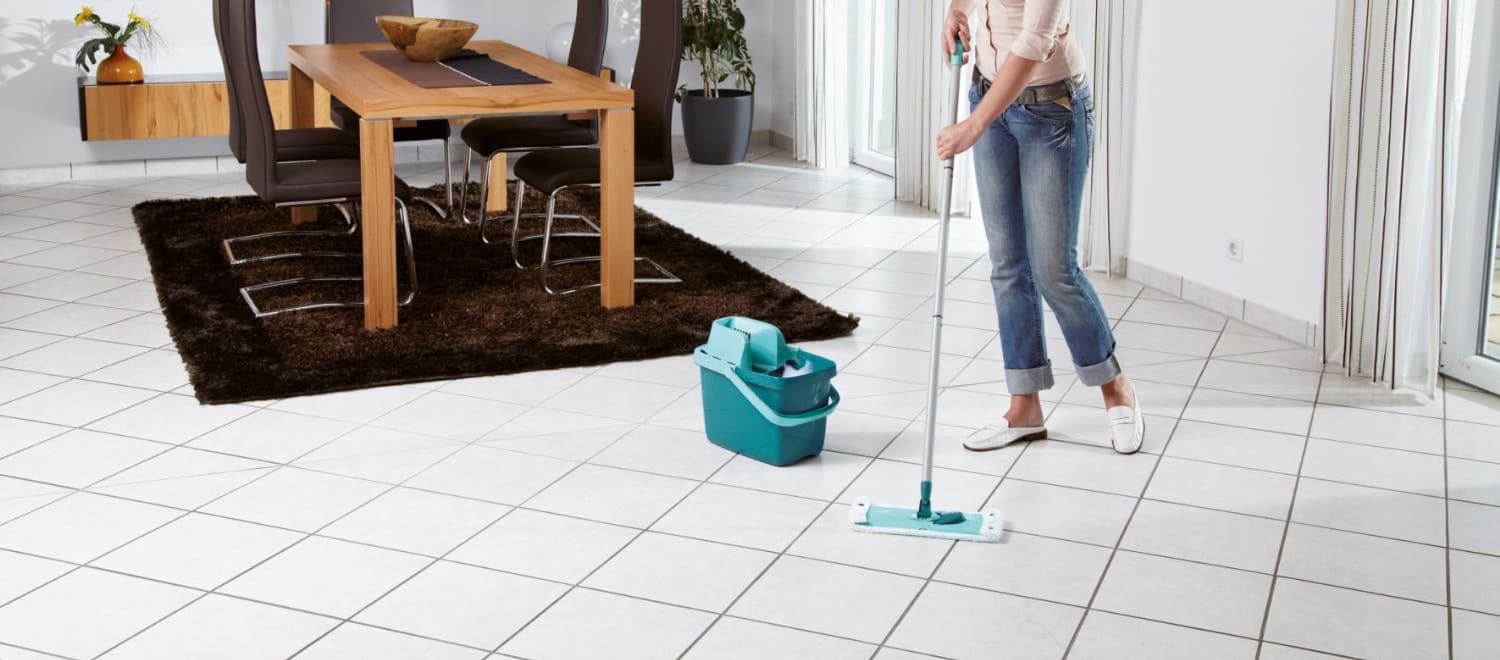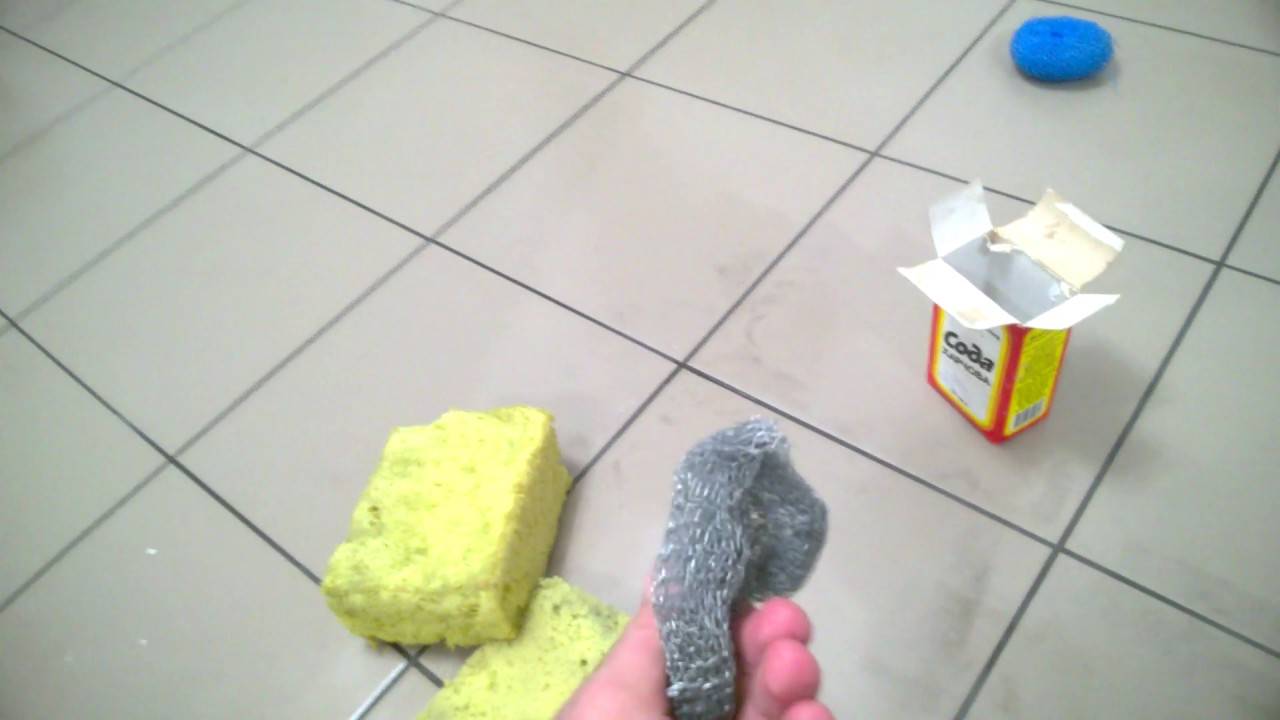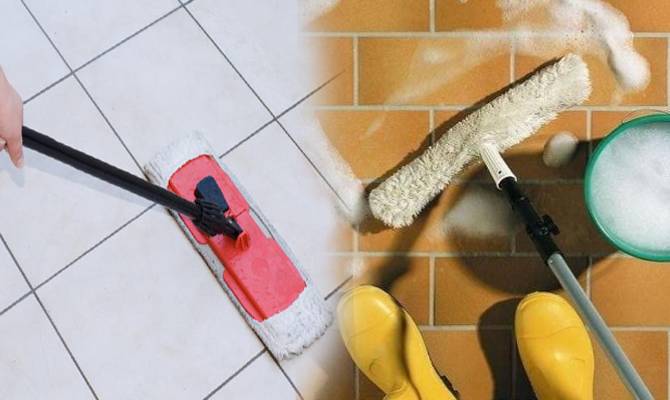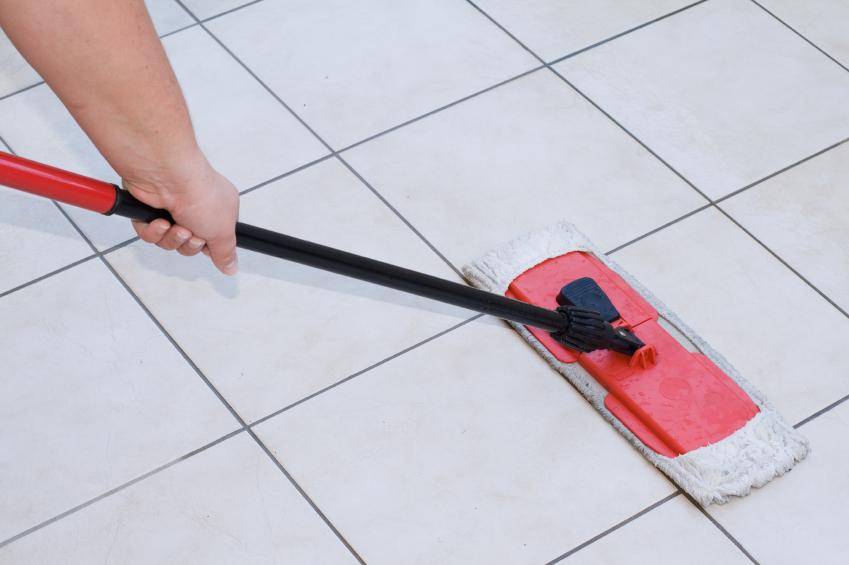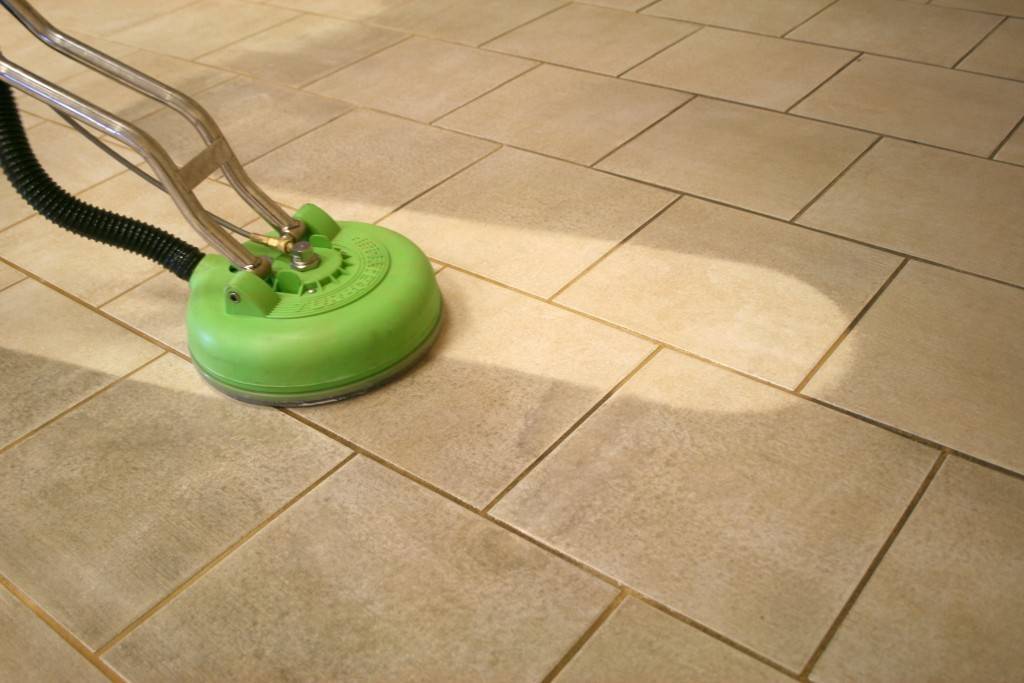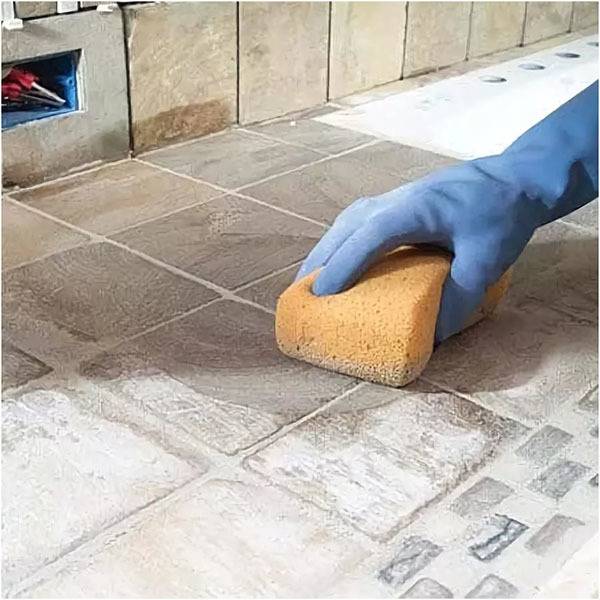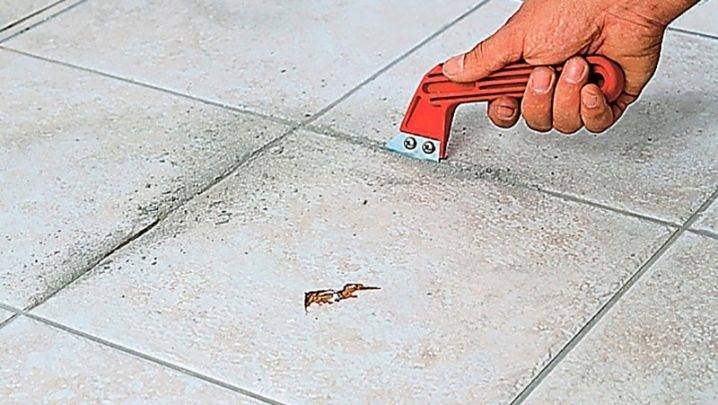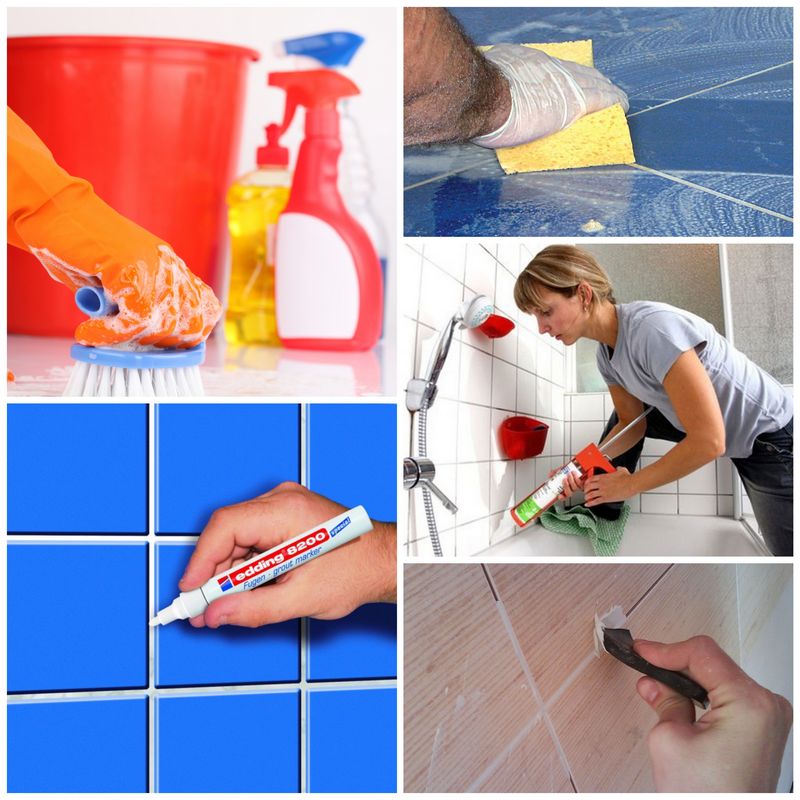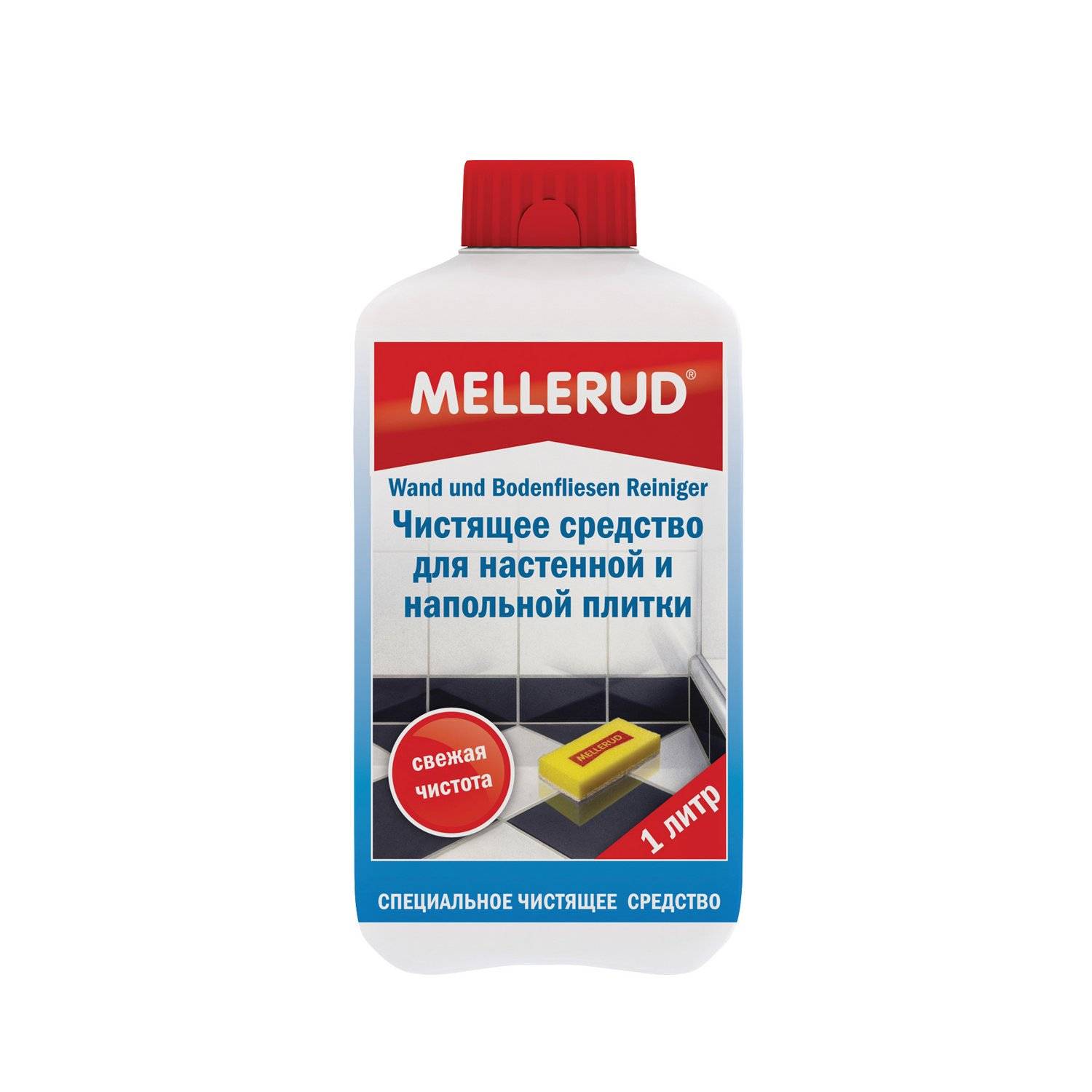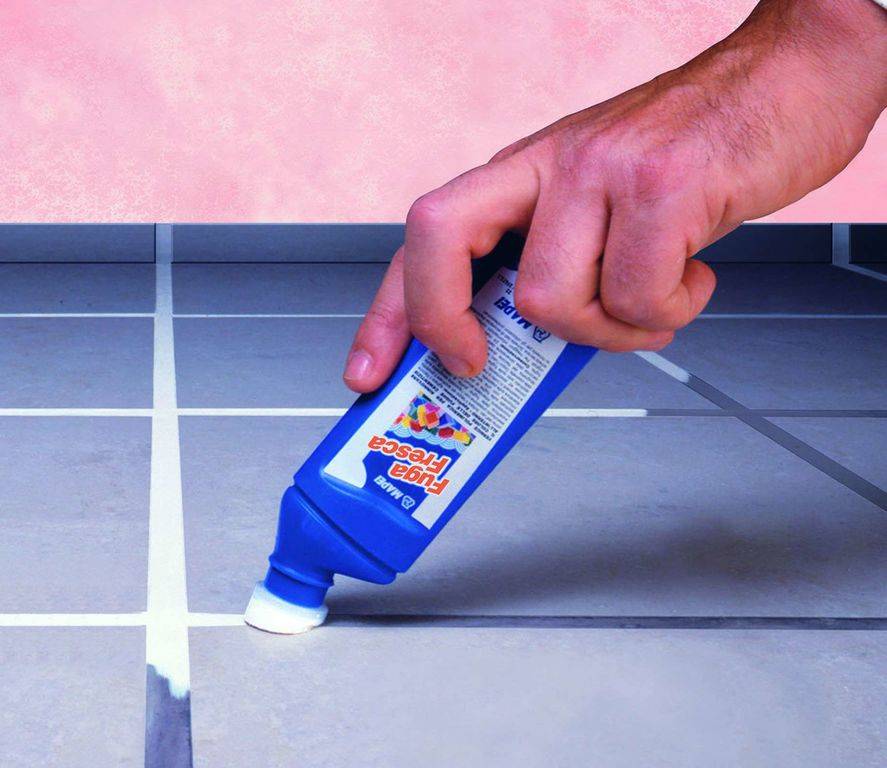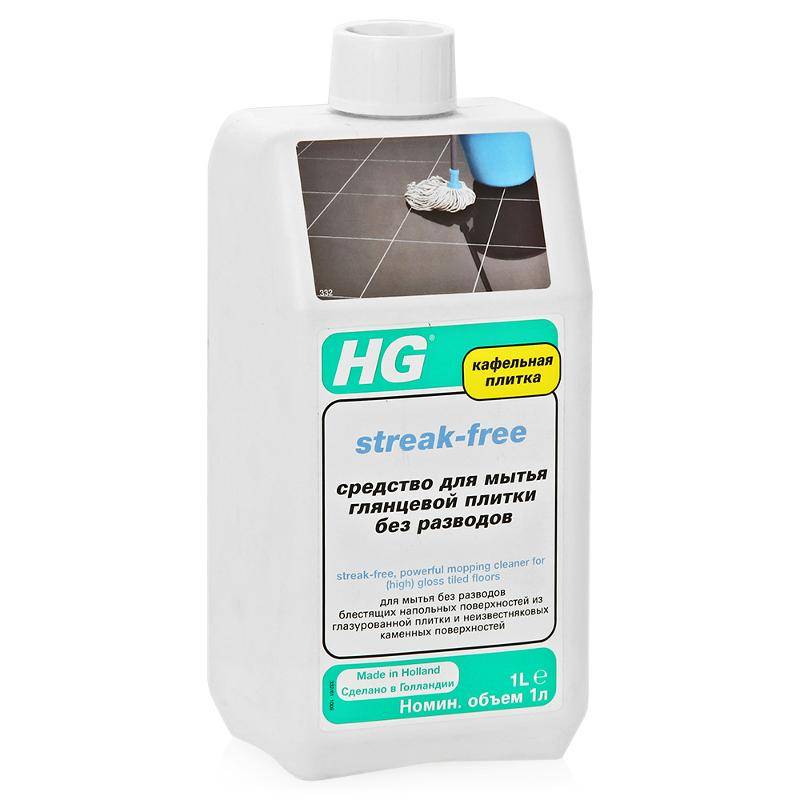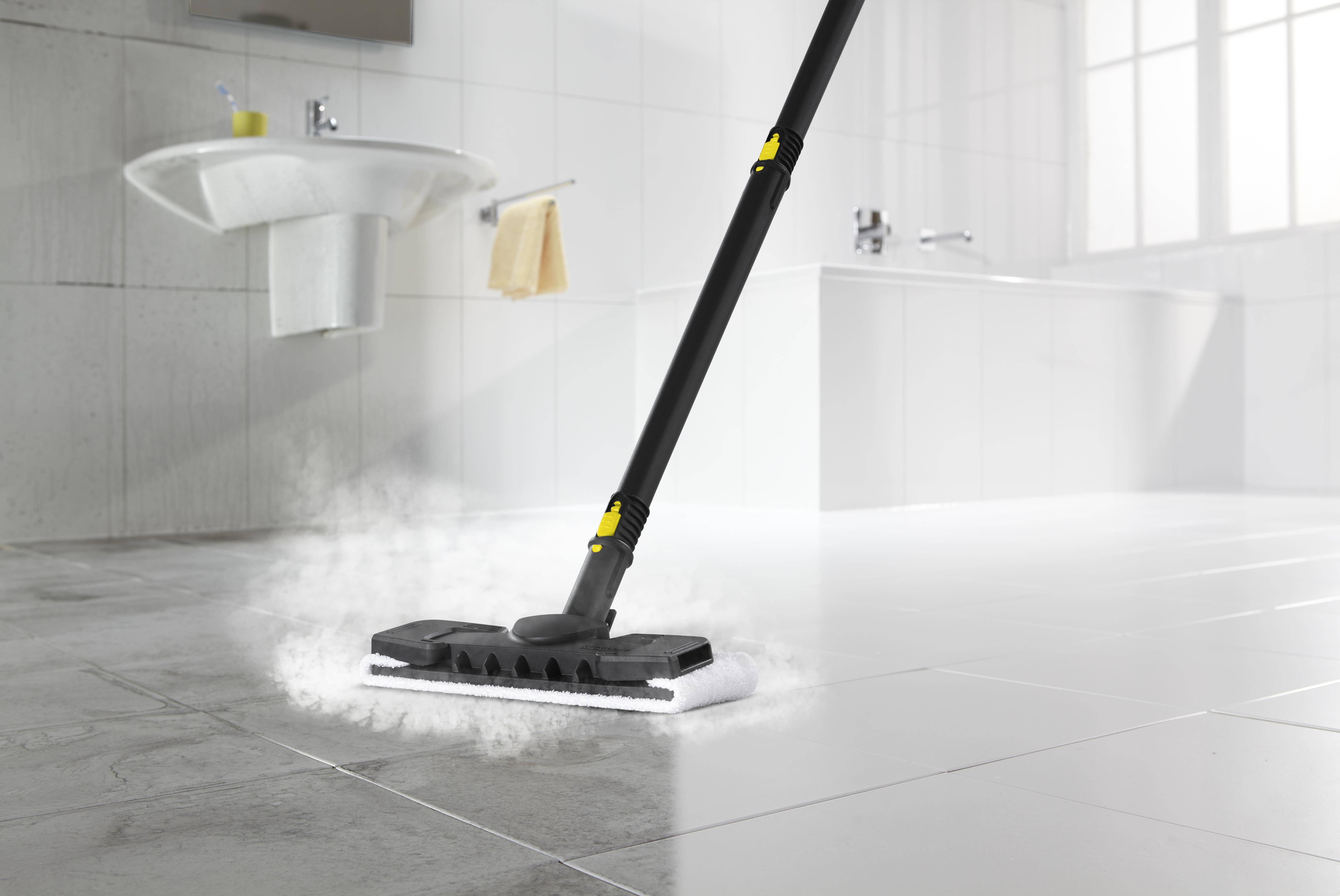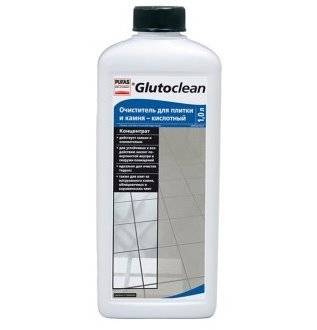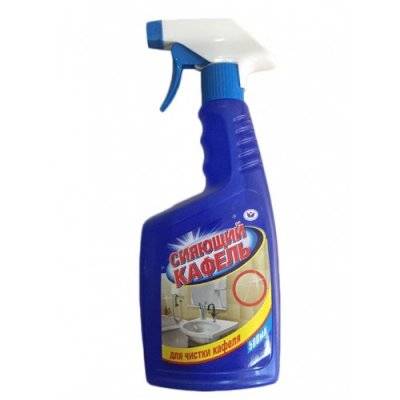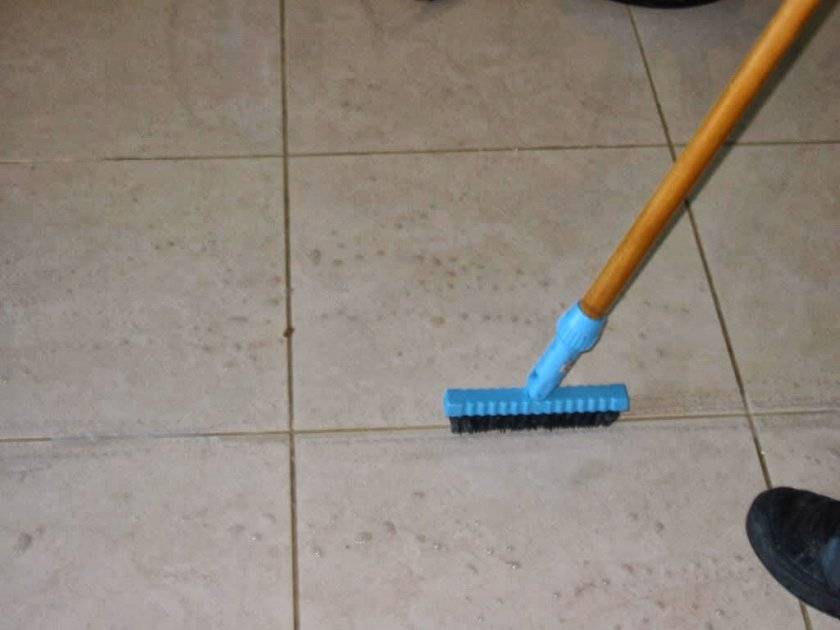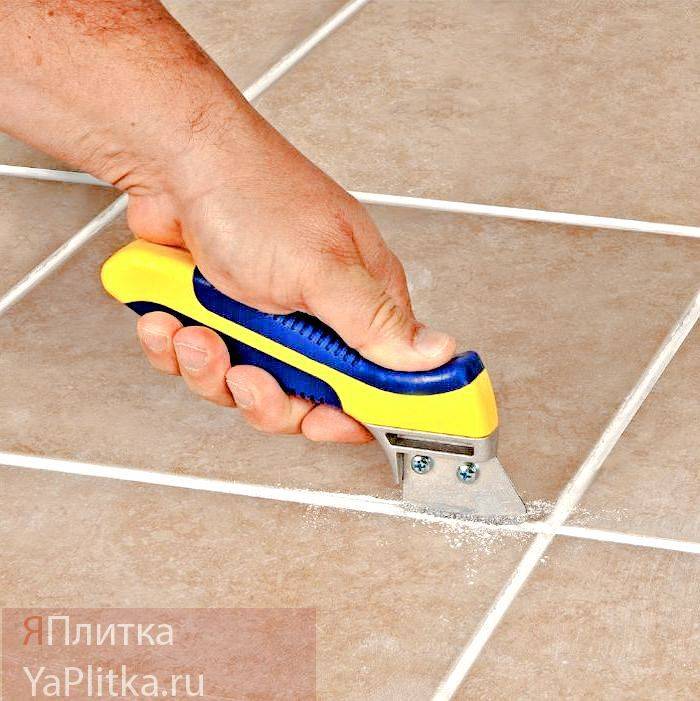How to clean tile joints: mechanical technology
Yes, the work is difficult, tedious and painstaking, but effective.
How to clean the seams in the bathroom photo
If we talk about the devices with which you can perform such work, then here you can only highlight sandpaper or a kitchen scraper. It is highly discouraged to mechanize this cleaning method and use all kinds of drill bits - the only thing you can achieve in this way is to damage the enamel of the tile.
Everything needs to be done by hand, which is the disadvantage of this method. Alternatively, you can use non-hard metal brushes, but they will remove the grout layer in stripes that are noticeable. A brush and emery cloth are good, of course, but a small, semicircular chisel, which is usually used by wood carvers, has shown itself best in practice. In principle, it is quite simple to make it from a thin tube, cutting it in half and sharpening the edge on a grinder.
After renovation
How to clean tiles after renovation?
It is somewhat more difficult to eliminate the consequences of repairs - especially in cases where the structure of the tile is porous and rough. "Harmless" construction dust is collected with a vacuum cleaner, otherwise the following approaches are used:
- It is necessary to wash off the glue "in hot pursuit". A vinegar solution (a quarter of a glass per 1 liter of water) will wonderfully cope with this task, it will also rid the tile of lime and putty. The brush should be quite stiff, but by no means metal - otherwise, scratches will definitely not be avoided. Repeat rinsing several times, then dry the tiles with a soft cloth.
- Hardened liquid nails are carefully separated with a scraper (to facilitate the process, the glue is soaked several times with warm water or acetone). You can do it in a completely different way: warm up the stained area with a building hairdryer and remove the solution as it melts (by the way, the same approach will eliminate the frozen silicone). Due to their structure, liquid nails can withstand temperatures from -5 to +50 degrees, so instead of heating, you can successfully freeze - the glue will crack and begin to crumble.
- Sticky scotch marks disappear instantly under the onslaught of acetone or a solvent like White Spirit.
- Use soapy water to wipe off fresh primer. Dried drops can be re-soaked with the same primer and wiped dry immediately. Of course, you shouldn't rush with this extravagant method - first try using thinner, gasoline, glass cleaner or a special paint remover. In some cases, polishing with soda paste or vinegar essence is effective.
- If putty gets on the tile, soak it with warm water and scrape it off diligently with a plastic spatula. Rinse the tiles with water and detergent, rinse and dry.
- Dried grout should be scraped off with a piece of woolen or felt cloth. Then the tiles are washed out using the same technology as in the previous case.
Tip: Moisture-resistant grouting mixtures can be used for minor cosmetic repairs: they perfectly mask chips and cracks on the tiles.
With a cement-sand mortar, of course, it is better not to hesitate: soak up the dirt with a wet sponge as it appears. If the solution still managed to harden, you have to work hard: first, soften it with cold water (you can drop a little lemon juice), then crush it and collect the dust with a damp cloth.
Table salt also helps to drive cement from the surface of the ceramic. Sprinkle the floor with dry grains, then moisten with water and leave for a few minutes.When the consistency becomes loose, remove the residue with a soft spatula or brush.
Aged solution can remove many toilet products. It is necessary to soak the stains for two or even three days, periodically apply a fresh layer of the composition
Finally, wipe the tile with a clean, damp sponge.
Grouts and silicone sealants can become a real headache if handled carelessly. After drying, the substances that make up their composition literally stick to the tile tightly, so soaking will also be required here.
Plain water, most likely, will not have the desired effect - it can be replaced by glass cleaner, pure vinegar essence, or any alcohol.
Another way to reduce the "Ceresita" type fugue is to treat the stains with diluted kerosene or a saturated solution of citric acid (half a glass of powder for 2 glasses of water). It is possible that the descaling agent in teapots will work.
Paint stains need to be treated with gasoline or thinner as soon as possible. To wash off the composition, first soap is used, and then clean water.
A lining spoiled by liquid glass will be put in order by a weak vinegar solution or just hot water. The stain is soaked for forty minutes (fix a wet cloth on the tile), and later brushed off with a toothbrush. Rinsing - alternately with soapy and clean water - is followed by treatment with a glass cleaner.
Advice: a special paint for bathrooms helps to give a "second youth" to worn cladding. The tiles are pre-sanded and degreased with acetone (try the procedure on one inconspicuous tile), after drying, varnish is applied in two layers. If you wish, you can limit yourself to the simplest pattern applied with epoxy paint on a stencil.
Necessary tools and tools
It is better to use some specialized products to clean the tiles. These can be purchased at any supermarket or hardware store. However, first you can try to get rid of the dirt with what you can find in the medicine cabinet or in the kitchen.
One such remedy is ammonia. It quickly removes almost any kind of dirt, and as a pleasant bonus it makes the tiles shine. But it has one serious drawback - a pungent unpleasant odor.
The next option is vinegar. It not only removes dirt, but also disinfects the surface. The disadvantage is a pungent odor, which is slightly weaker than that of ammonia. Citric acid, as well as the natural juice of this citrus, is a good anti-fat agent. It can also help remove limescale.
If a tile cleaner is not available, you can use a cookware product. They have a fairly similar composition, and it removes dirt well. The disadvantage is a significant amount of foam, which will take more time, since it will take a long time to wash it off, but the most important thing is to dissolve the above products (as well as store products) in clean water. To do this, you can skip the one that is taken from the tap through a household filter.
Baking soda is great for cleaning seams. In 1 liter of water, 3 tablespoons of the substance are diluted. This liquid is used to wipe the tiles and joints using a sponge. Soda water makes the spaces between tiles lighter. After completing the cleaning, it remains to remove the stains with a damp cloth. If the joints are very dark, the baking soda can be combined with a substance containing chlorine. For example, use laundry bleach or washbasin and toilet cleaner: Domestos, Sif, or the like.
The bleach is combined with baking soda to form a paste. With this tool, the seams are treated so that there are no unworked areas left - if you miss something, then spots will remain on the floor or wall. The paste should dry completely. Wash it off with a brush and water.You can use such a tool only if the grout at the joints between the tiles is white. On colored joints, even very light ones, such compositions cannot be used - it is easy to spoil the appearance of the coating.
When tidying up the tiles, open the window to the kitchen and close the door at the same time so that the pungent smell of chlorine does not spread throughout the apartment. A mixture of soda and hydrogen peroxide will help remove dirt from tiles and seams. For half a glass of sodium bicarbonate, take 70 milliliters of peroxide, add a little dishwashing gel or liquid soap. The mixture should be like porridge in consistency. It is distributed over the tiles, wait 10 minutes, and then washed off, wiping the seams well with a sponge.
Ammonia
To clean tile and ceramic tiles, ammonia is often used. The sponge is moistened in it and passed along all the seams.
You can do otherwise: dilute 120 milliliters of ammonia in 4 liters of water and spray it onto the surface from a spray bottle. Rinse off after 15 minutes. The tiles will shine with gloss and cleanliness.
Mustard
It is advised to use dry mustard as a mushy cleaning mass. It is diluted to the appropriate type of sauce and applied to the seams and the surface of the tile. After cleaning with this product, the kitchen shines with cleanliness.
It goes without saying that you should not clean dirty floors with your bare hands.
Therefore, you need to stock up on the following items in advance:
- doormat;
- hard old brush for cleaning teeth;
- broom for sweeping the floor:
- a few rags:
- clean warm water;
- hydrogen peroxide;
- vinegar or citrus juice;
- soda;
- salt;
- solvent;
- mustard powder;
- ammonia;
- whitening cleaning agent with abrasive particles;
- small metal hard sponge;
- old small knife.
We clean the tiles
Any action must begin with preparation. In our case, this is the choice of a detergent - first of all, decide what you will use for yourself - the folk method or a specially developed solution, powder or gel.
The tiles must be wiped dry
Folk remedies
Despite the fact that progress has gone far ahead, many remain faithful to the good old "grandmother's" methods. And this is no accident. The price of these funds is simply symbolic, the verification is considered for decades, and the effectiveness is not inferior to the most famous advertised products. And also these funds are always at hand - you do not need to go to the supermarket for them, choose, spend money.
Remove the large debris first.
We have collected all the most effective in the table, "seasoning" with the wonderful properties of these substances.
| Microfiber cloth + dishwashing liquid | The first element gently collects stubborn dirt, and the second one destroys the structure of fat and other dirt. |
| Bleaching powder | Ideal for white tiles and the answer to the question "How to wash the tiles in the bathroom?" And plus - excellent disinfection. |
| Chalk + paper | The perfect combination for cleaning glossy tiles. Chalk fights dirt, and paper treatment after it dries gives the tiles a pristine shine. |
| Citric acid (lemon juice) | In the literal sense of the word, it corrodes fat and other dirt - it is needed by seekers than to clean the tiles in the kitchen. |
| Vinegar | Cleaning and disinfection - two in one. |
| Ammonia | Ammonia has an unpleasant odor, but it fights dirt very effectively and returns the shine to the surface. |
All products are used very simply - they are diluted in water, after which the surface is treated with a solution.
The soap solution must be washed off with clean water.
Special equipment
But in some cases it is still better to give your preference to special means. We list the most powerful and proven ones, which makes it very easy to clean the tiles.
"Silit"
One of the most effective means, the result of which is visible in a few minutes.Suitable for both wall, ceiling, floor tiles.
Remedy from "Amway"
Doesn't make any claims about efficiency. But it is distinguished by the high price
Many housewives also pay attention to the active gel from this company - it can be added to other products to further activate their action.
"Selena"
And this tool, on the contrary, is one of the most economical. Perfectly removes both stains and grease stains.
"Mister proper"
Both a universal product and products from a special line for tiles will help.
Melamine sponge
The miracle sponge that you saw in the photo already contains an active substance - so you just have to wet it and then treat the surface with it.
Many people say that it is excellent at fighting stubborn fatty deposits.
"Mister Muscle"
A non-trivial way - but this glass cleaner with the same effect will remove stains from the tile and give it a shine.
Pay attention to a number of products containing chlorine. This component perfectly fights traces of rust, limescale, and also disinfects tiles.
Now let's move on to the process itself.
Correct algorithm
To make the state of the tile ideal by the end of cleaning, we advise you to adhere to this order in your actions:
- Use a rag, brush, mop to remove all large debris from the surface.
- Wipe off the dust thoroughly with a dry cloth and rags.
- Dilute one of the selected products in a bucket and treat the surface with a sponge, rag, brush dipped in it. Physical effort may be required for cleaning to be effective.
- Rinse the foam off the tile with clean water.
- If the contamination remains, it's time to apply a more serious remedy against them. For convenience, it can be sprayed with a spray bottle.
- Rinse the tiles clean again with water.
- Finally, use a surface glossing agent. It can be replaced by rubbing with paper or dry cloth.
The video in this article will clearly demonstrate these actions.
How to clean the seams
If the tile itself is easy to clean, then dirt gradually accumulates in the seams. They absorb liquid and can darken or become a breeding ground for mold. Use other means to clean the seams: acids and corrosive powders can damage them. There are several effective and safe methods.
- Light dirt can be removed with a regular eraser.
- Make a paste of equal parts baking soda and water. Apply to seam and rub with a soft brush.
- For light colored seams, you can use bleach. It must be diluted 3: 1 with water and applied to the seam, and then brushed.
- Mix equal parts hydrogen peroxide, baking soda and dishwashing liquid. Apply to seams, rinse off after 2 hours.
- To remove mold, you need to dilute a glass of borax in 3 liters of water. Apply to seams and rub. Do not rinse, only wipe with a dry cloth.
- Dilute 100 ml of vinegar with the same amount of water, add 500 g of baking soda. Apply to seams, brush over them after 15 minutes.
The first place in the maintenance of tile floors is a broom and a spatula. The use of a broom has been known for centuries and although the material from which it was made has changed, the principle of its operation is the same. Use a broom for surface cleaning - collecting dust, debris. Then, by applying one or more of the products listed below, you will achieve a perfectly clean floor.
Some dirt cannot be removed with a broom and a spatula. This is, in particular, spilled liquid, typical of the kitchen floor. In this case, use a bucket and floor mop (mop). Mops are usually made with a cotton or sponge pad. A cotton mop is more suitable for removing stubborn stains. The porous surface of the sponge squeegee will be useful precisely when it is necessary to remove spilled liquid.
How to clean dirty tiles without streaks:
- It is best to do the worst job first - cleaning the seams and corner joints, then scrubbing the floor. To clean the seams, apply detergent to them, leave for a few minutes. We clean the joints with a brush (for example, a toothbrush), remove the residues of cleaning substances with a cloth and, finally, wash the entire surface of the floor.
- Use a mild all-purpose detergent diluted with water to clean the tiles. Apply the solution to a small area of the floor, let it sit for a few minutes. While one area is soaking, work on the other. Then return to the first cleaned surface, wipe it with a clean cloth. The floor will shine like new.
- To keep the tile clean and shiny, remember to re-clean it as needed (in the kitchen, several times a week). Cleaning once a month is not enough. Purchase a suitable floor mop. Keep it handy. Try to wash every stain that appears.
Sometimes you have to scrub the tiles on the floor, not only from dirt and limescale. A relatively common problem is mold in corners and seams.
How to remove fungus from tiles:
- Sweep the floor with a broom, collect dust, large particles of dirt.
- Mix:
- ½ tbsp. soda;
- ⅓ Art. ammonia;
- ¼ Art. vinegar;
- 7 tbsp. warm water.
- Pour the solution into a spray bottle.
- Spray the mixture on the part of the floor with the seams affected by the fungus and immediately absorb the liquid with a cloth or vacuum cleaner. Do not allow water to enter the joints. Continue until you've scrubbed the entire floor. If necessary, this mixture can be used again to eliminate the fungus.
- Use a cloth or paper towel to remove any remaining water from the cleaned seams.
How to cleanse fat
Use vinegar and baking soda to remove stubborn dirt and grease from your tiles. This mixture will dissolve dried dirt, soften the fatty deposits characteristic of the kitchen. Use both ingredients to create a paste and apply to the tile, leave for a few minutes. Wipe with a damp cloth.
Vinegar and baking soda are suitable for cleaning textured (rough) tiles, regardless of color. This mixture will refresh the light surface, return the brightness to the colorful tiles.
You can also use lemon. It is an excellent cleaning aid that easily removes stubborn stains (from soups, sauces, other products sticking to the tiles). Wipe the dirt with a sliced lemon slice or juice. Dirt, even if it is heavily eaten, will dissolve.
How do I clean the tiles after the renovation is complete?
It is almost impossible to protect walls and floors from splashes, drops, drips, stains during finishing work. However, you can prepare for the subsequent cleaning of the tile. Moreover, it is not difficult to do this, since the building material used in the course of the work is known. For decorative finishing of the bathroom with tiles, use:
- glue solution;
- grout;
- primer;
- plaster;
- silicone sealant.
In addition, there may be spots of lime, paint, polyurethane foam, traces of construction dust on the tiles. The simplest algorithm of actions before washing the tile assumes:
- cleaning the walls with a vacuum cleaner from dust and adhering particles of building materials;
- scraping off solidified particles of hard building materials with a small blade or soft spatula;
- washing of smeared building mixtures with special solvents;
- wet wall cleaning with detergents;
- polishing the tile.
Most builders can be removed from specialized stores.
Adhesive mortar and silicone sealant
Even with the most careful facing work, excess adhesive will appear in the seams. They must be removed immediately just with a damp cloth and a spatula. If the mixture is dry, then:
- You can wipe off the tile adhesive after it gets wet under a damp cloth. To eliminate polymer glue, the fabric is moistened with a solution of acetone, ammonia, vinegar. A solvent will help remove epoxy stains.
- You can try to remove the dirt mechanically.To do this, use sandpaper, a stiff brush, a scraper. It is necessary to act very carefully so as not to spoil the glaze layer.
- Porous ceramics will be more difficult to clean because the compounds are deeply embedded in the structure of the finishing material. In order to find the right solvent, you should know what kind of glue was used. On the packaging of building materials, manufacturers indicate a solvent suitable for cleaning.
A silicone sealant used to seal joints (for example, between a bathtub and a wall) protects against moisture and prevents the development of mold and mildew. For accurate application of the sealant, it is recommended to protect the surfaces with masking tape.
This building material adheres firmly to any surface, and it is extremely difficult to remove dried sealant. It will have to be cleaned mechanically (with a scraper, blade) or chemically (white spirit). Both methods are dangerous for adjacent surfaces, the result can be scratches, chips, areas corroded by chemicals with a violation of the structure, color and loss of gloss.
We remove the primer and cement
These building mixtures are also easier to remove immediately. This does not require effort, a sufficient wet rag. If dried stains are found on the tiles after the end of construction work, then the first step is to try to soften them. Moreover, you can try to moisten the stains of the primer with a fresh primer, and then scrape off with a scraper. A cloth and a scraper moistened with hot water are suitable for cement.
Grout
Most often, the tiles in the bathroom after repair have to be cleaned of grout. The use of a grout mixture is the finishing stage of finishing work. Experienced craftsmen carry out sealing of seams and removal of excess mixture at the same time, while trying not to smear the composition on the tiles, wipe thoroughly with a dry and damp sponge.
Dried grout stains are washed off easier than glue solution, but the procedure will have to be repeated several times. After the top layer has dried (the seams become lighter), the wall must be moistened with clean water, and then washed off with another clean sponge.
If epoxy grout was used, then you cannot do without a special solvent.
Primer
Now let's consider how you can clean the ceramic tiles from the primer after repair. White spots often remain on the floor tiles, since the installation of the wall cladding is done after it has been laid. It is advisable to spread a protective film on the floor, but it does not always give a 100% guarantee of stain protection.
If the primer gets on the tiles, it is advisable to rinse it off with clean water as soon as possible. When the substance dries, it will harden and it will be much more difficult to wash it off. For this purpose, you can use the following tools:
- special solvent based remover;
- acetone;
- polyurethane foam;
- fresh primer.
Once the stain has softened, you can try to clean it off. You can also use a special scraper with a sharp blade to remove drops of frozen paint from glass surfaces.

It is best to rinse off the primer before it hardens with clean water or solvent.
Cleaning methods
Several methods are used to clean the grout between the tiles:
- chemical agents of various types;
- time-tested folk recipes and methods;
- removal of dirt and mildew by steam cleaning.
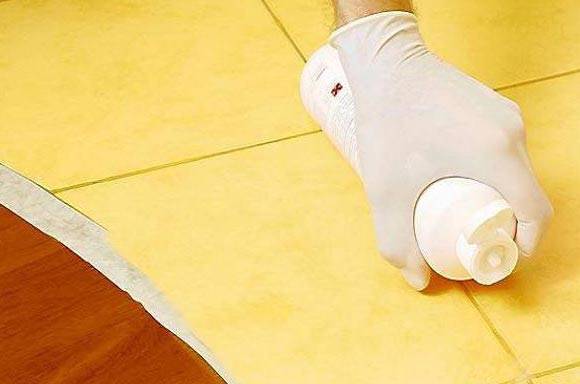
Dust and a thin layer of dirt can be easily removed with soap solutions. Grease must be washed with breakdown fluids. Fungal formations are treated with antiseptics. To remove limescale, you need an abrasive powder.
Manual mechanical cleaning
It is possible to return the novelty to the seams between the tiles without the use of household chemicals, but this implies a lot of effort.
First, you will need to intensively scrub the top dirty layer of grout with a stiff brush. Some housewives even use a metal brush. Then you need to thoroughly wash the floor first with soapy water, then with clean water.
Household chemicals
The modern household chemicals market offers a large number of products with different properties that can easily and quickly clean even the most difficult dirt.

To clean the seams between tiles on the floor, abrasive powders are most often used, which are applied to moistened surfaces and intensively rub the fugue with a brush or hard sponge.
Sprays and emulsions are gaining popularity, which include acids, antiseptics, fat solvents and other components that can quickly remove any type of dirt and prevent its early appearance.
Due to the aggressiveness of such formulations, their use implies protective equipment (gloves, respirators, clothing with long sleeves).
In addition, you must strictly follow the instructions for use, which must be printed on the packaging.
Steam cleaner
Effectively it is possible to remove dirt of any complexity with the help of steam generated by an iron or a steam cleaner. In this case, the second device is better suited, since the hot air jet is more concentrated and has an accurate directionality.

This cleaning method is completely safe. It does not include the use of harmful chemicals and the result is excellent. All harmful microorganisms die under the influence of high temperatures.
To implement the method, you should go through the problem areas several times so that the steam dissolves the dirt, and then wipe it off with a clean cloth.
How to wash porcelain stoneware
Cleaning porcelain stoneware depends on the degree of soiling.
If, during the repair work, the dirt was removed from the tiles immediately, then after the repair is completed, it will be enough to wash the tiles from the resulting dust. This requires:
- Clean the surface from coarse debris and other contaminants.
- The remaining dust on the porcelain stoneware is cleaned with a damp cloth soaked in any soap solution.
- To prevent the appearance of streaks, the fabric used must be thoroughly rinsed in water.
- After cleaning the floor, it is recommended to rub the tiles with a dry cloth.
Cleaning methods
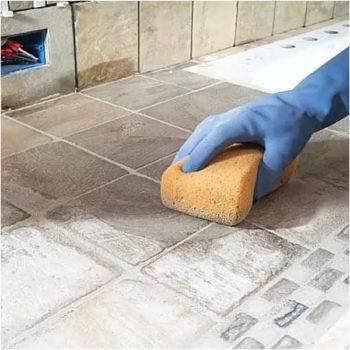
How to clean the tiles after repair
How and what to clean the tile surface after repair, simple and more complex ways
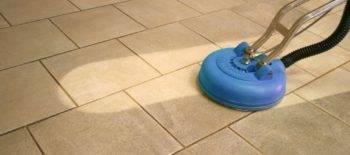
How to clean floor tiles
How to clean floor tiles, expert advice, choice of detergents
Removal of dried stains is carried out using mechanical or chemical methods:
- The mechanical method involves cleaning contaminants with a knife, construction float or sandpaper. But using this method, you need to be extremely careful, as there is a risk of damaging the glazed coating of the tile. The following contaminants are wiped off mechanically:
- adhering lumps of cement;
- the rest of the putty;
- polyurethane foam.
- Chemical cleaning methods provide for the following technology: to remove stains, you first need to soak them by laying on them a cloth soaked in a solution chosen depending on the type of pollution.
The table shows the types of porcelain stoneware contamination and methods for their cleaning:
| Type of pollution | Means and method of cleaning |
| Polymer glue | The fabric is moistened in vinegar or acetone |
| Epoxy adhesive | Only solvent will work here. |
| Paint stains | A solvent is used that is designed specifically for this type of paint. If the stain is old, pre-soak it with a cloth soaked in solvent and laid on the stain. After that, the stain is rubbed and removed completely |
| Water based paints | Rub off with plain water |
| Removing grout | To facilitate the removal of grout, it is recommended to moisten the tiles with plain water before grouting. The resulting dirt is removed simply with a damp sponge. If the grout is old, the tiles are cleaned only with acidic agents. When using acidic substances, care must be taken that they do not fall on the seams, as they will damage the solution |
| Whitewash | Whitewashing is removed in several stages:
|
| Household contamination (grease, dirt, food stains, etc.) | Cleans depending on the degree of contamination, in most cases, a soap solution is sufficient |
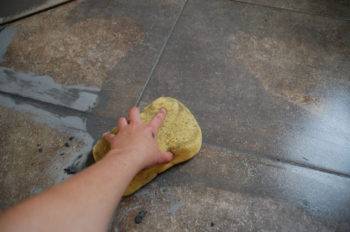 Cleaning grout from tile surface
Cleaning grout from tile surface
Cleaning of tile joints
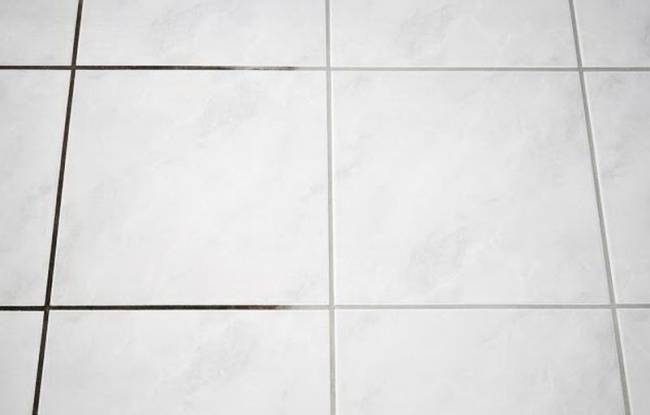
How do I clean the joints between tiles?
Regular hygiene is needed not only for the surface of the tile, but also for the joints between the tiles - these places are especially vulnerable to dust, soapy deposits, dirt and mold. How to remove dirt between tiles? Here are the tried and tested methods:
- The easiest way to get the seams in good condition is to bake them with baking soda. To do this, you need an old toothbrush or brush: moisten and sprinkle the bristles liberally, rub the resulting gruel diligently into the joints. You should not rush to rinse - leave the paste for at least a quarter of an hour. For preventive purposes, it is advisable to repeat this procedure on a weekly basis.
- At an early stage of infection with a fungus (when the seams acquire black dots), vinegar must be actively connected to the cleaning, and in a concentrated form. Such treatment will prevent the spread of mold and return the tiles to their former "well-groomed".
Attention: on tile joints covered with a layer of sealant, use vinegar with extreme caution. If you get too carried away with such disinfection, the grout may need to be replaced very soon.
- If the light seams have darkened noticeably, they can be freshened up with household bleach (it is better to take an oxygen-based product - for example, "Vanish") or a powerful cleaner like "Domestos". The principle of operation is the same as in working with soda, the composition should be washed off several times in a row.
- Among folk remedies, hydrogen peroxide has proven itself brilliantly: it can both whiten and eliminate mold. All you need to do is moisten a sponge or a piece of cotton wool, and then slowly walk along the joints. Even more productively, peroxide works in tandem with soda or dish gel, they are simply mixed and left on the seams for about a couple of hours. Finally, the joints are wiped with a brush and rinsed with clean water.
- Copper sulfate can also stop the "adventures" of the fungus. For one liter of water, measure 30 grams of granules, the finished solution is poured into a spray bottle. Before using this antibacterial spray, it is imperative to clean mold areas with a stiff brush and soapy water.
- It washes away mold between borax tiles very well. The powder is diluted in clean water at the rate of 200 grams per 2.5 liters. The product does not require rinsing - lingering on the surface, it forms a persistent protective barrier.
- Certain essential oils, such as tea tree and grapefruit, have made impressive progress in fighting fungus. Natural antiseptics are combined with alcohol and water (2 teaspoons per half glass, respectively). You can distribute the liquid with a spray or sponge.
- In advanced cases, when the cladding has practically nothing to lose, rough mechanical grinding is possible - with sandpaper, a nail, a special machine or grinder. After cleaning, the joints must be disinfected and primed. Later, using a rubber trowel, a new layer of grout is applied.
To protect the seams of ceramic tiles, special agents are produced - sealants. They clog the pores of the grout, preventing dust and dirt particles from getting stuck. Washing the treated joints is not accompanied by any difficulties, the main rule is not to get carried away with aggressive acid cleaners.
Tip: When applying a transparent sealant, you need to be extremely careful.So that the tenacious composition does not fall on the surface of the tiles, it is recommended to paste over their contours with tape, and, of course, it is best to entrust this painstaking task to an experienced specialist.
If you are pursuing a purely cosmetic goal in updating the seams, it makes sense to think about buying a special plumbing pencil. The waterproof trowel masterfully fills the joints with a snow-white dye, and thanks to the convenient design, even an inexperienced master can handle the application of "white" (usually there are several nozzles of different thicknesses in the kit). The composition of the dye has an antibacterial effect, which greatly facilitates the reduction of mold. It is worth noting that the wonderful felt-tip pen is not only white - it is possible to choose a shade for any tile color.
Preventive work
The end of the renovation is always a real treat.
In order not to panic at the thought of the upcoming global cleaning of dirt and remnants of unnecessary materials, it is important to think in advance what stains and what can be removed, how to do it easily and quickly, while without high costs for expensive household chemicals
There are many ways to cleanse, but prevention of contamination should not be neglected. It is carried out in this order:
- All surfaces should be covered in advance with protection - these can be cardboard boxes, paper, oilcloths, and other materials at hand. When laying floor tiles, the protection must be fixed to the walls.
- In the process of carrying out work, with the help of a cloth or sponge, the dirt that has gotten is immediately erased so as not to wait until it hardens.

